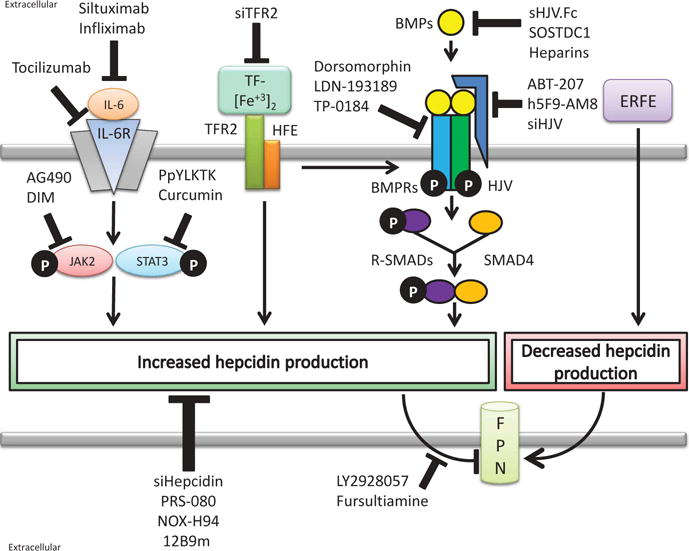Figure 3.

Overview of hepcidin antagonists. Hepcidin antagonists reduce hepcidin production or inhibit hepcidin function. The interleukin-6 (IL-6), iron sensing, and bone morphogenetic protein (BMP) pathways increase hepcidin production, while erythroferrone (ERFE) decreases hepcidin production. In the IL-6 pathway, secreted IL-6 binds the IL-6 receptor (IL-6R), activating janus kinase 2 (JAK2) and subsequently signal transducers and activators of transcription 3 (STAT3). STAT3 binds to a STAT3 response element in the hepcidin promoter to stimulate hepcidin synthesis. Targeting the IL-6 pathway, siltuximab and infliximab reduce IL-6 availability while tocilizumab interferes with IL-6R binding. Downstream, JAK2 inhibitors AG490 and 3,3′-Diindolylmethane (DIM), and STAT3 inhibitors PpYLKTK and curcumin, also interfere with IL-6-stimulated hepcidin synthesis. In the iron sensing pathway, diferric transferrin (TF-[Fe+3]2) binds to transferrin receptor 2 (TFR2) and associated human hemochromatosis protein (HFE) to increase hepcidin synthesis. Small interfering RNA targeting TFR2 (siTFR2) reduces hepcidin production by the iron sensing pathway. Downstream signaling of the iron sensing pathway is yet to be worked out but may involve stimulation of the BMP pathway. In the BMP signaling pathway, secreted BMPs bind to BMP receptors (BMPRs) activating intracellular receptor SMADs (R-SMADs) and SMAD4. SMADs bind to BMP-responsive elements in the hepcidin promoter stimulating hepcidin synthesis. BMP signaling can be enhanced by the hemojuvelin (HJV) coreceptor. A soluble HJV conjugate (sHJV.Fc), SOSTDC1, and heparins reduce hepcidin expression by sequestering BMPs. Dorsomophin, LDN-193189, and TP-0184 interfere with BMP receptors while small interfering RNA against HJV (siHJV) and HJV targeted antibodies (ABT-207 and h5F9-AM8) also reduce BMP signaling. Finally, several hepcidin antagonists interfere with hepcidin-FPN interactions. Small interfering RNA against hepcidin (siHepcidin), PRS-080, NOX-H94, and 12B9m specifically target hepcidin, while LY2928057 and fursultiamine prevent hepcidin binding to FPN.
